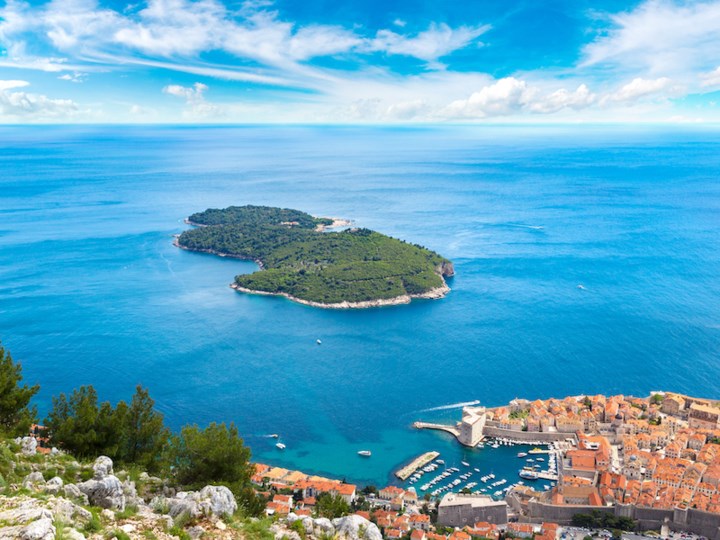Driving along the coast of southern Croatia towards Dubrovnik and looking at the sea, you will be
amazed by the beautiful blue Adriatic Sea and the small scattered islands.
The Elaphite Islands are a group of islands located west of
Dubrovnik. The name comes from the Greek word elaphos, meaning
deer. The Elaphite Islands were first mentioned under this name in the 1st century. There are two theories how the group of islands got its name. According to one, deer used to live on the islands. Another theory is that the islands, viewed from
Srd, a hill above Dubrovnik, together create a shape of a deer. If you have booked your holiday in
one of our beautiful villas in Dubrovnik, a visit to Srd and enjoying the view of the city and the Elaphite Islands is a must do.

The archipelago consists of
13 islands, some of which are still inhabited today. The largest islands are
Sipan, the furthest from Dubrovnik, whose name is of Greek origin and means eagle's nest, and
Kolocep, which is closest to Dubrovnik.
Sipan has been connected with Dubrovnik since the 15th century. The inhabitants we engaged in
maritime affairs, shipbuilding, olive growing, fishing and viticulture. In the 17th century the island stopped developing, the population emigrated, but in the 21st century the island is experiencing revitalisation. On a small area of only 16 km2 there are as many as 42 old summer houses and
34 churches. In the time of the Dubrovnik Republic, Dubrovnik landowners built their summer houses, churches and chapels on Sipan and other islands. Unfortunately, many are now privately owned and neglected.
Kolocep, the most southern island, and thus the closest to Dubrovnik, offers subtropical vegetation and fresh sea air. Due to its untouched nature -
pine forests and olive trees, this island is often a picnic spot for the Dubrovnik residents, but also for their guests. The island is special due to the fact that it is probably the only island in the Adriatic that has two names. The locals call it
Kalamota, from the Greek word kalamos, which means fishing rod. In the past the island was known for olive growing, viticulture, coral hunting and shipbuilding, there was even a
shipyard. But today, due to the small population, the only industry on the island is tourism. We all know the story of
Christopher Columbus and his travels to the seas of the world. According to some records, two members of his crew aboard the
Santa Maria were from the island of Kolocep.

The third largest island is
Lopud, located between Sipan and Kolocep, and it is considered the
most developed island, although its area is slightly less than 5 km2. According to some archeological findings, the island has been inhabited for thousands of years - the remains of Roman, ancient Greek and Slavic buildings have been found. In the 15th century, Lopud became one of the seats of the Republic of Dubrovnik, and this was reflected in the development of the island. On the island there was shipyard and mills, land that is neglected today once was cultivated, the inhabitants were also engaged in
fishing, viticulture and cattle breeding. Today’s island park was once the garden of a 19th-century villa, and it is home to
plants that the islanders collected in their many voyages around the world, such as eucalyptus, bamboo and various types of cactus. If you are looking for one of the
most beautiful sandy beaches on the Adriatic, be sure to visit the bay Sunj and its sandy beach.
Kolocep, Lopud and Sipan are connected to
Dubrovnik by a regular ferry line. There are
no cars on Kolocep and Lopud, but you can explore the islands by foot.
The other islands also attract Dubrovnik residents and tourists with their landscapes and sandy beaches, as well as with with
abundant cultural and historical heritage and legends. The smaller islands of the archipelago are uninhabited, but there you can find the
remains of sacral heritage - churches, chapels and monasteries, as well as the remains of fortifications from the Napoleonic era. The islet of
Andrija is a habitat for various species of birds, and has been declared an
ornithological reserve. The island is also associated with a legend, which is confirmed by a document from the 15th century.

According to
legend, a young man from an influential family, Ivan, and an ordinary peasant girl, Mara
fell in love. Due to the difference in social classes, their love was
forbidden. Unfortunately, the love ended unhappily, and as a memorial to their love, today there is a
lighthouse on the island of Andrija.
The Elaphite Islands are not only interesting for tourists.
Many celebrities who sail the Adriatic on their yachts visit the Elaphite Islands. One castle on the island of Sipan attracted the attention of Belgian King Albert II, who was interested in buying the castle because he was delighted with the islands, nature and the crystal blue sea.
We suggest you stay in
one of our beautiful villas with pool in South Dalmatia, where you can
relax and enjoy, as well as explore these pearls of the Adriatic Sea.
Tina Sarson
2.9.2022

 MY ISTRIA GUIDE
MY ISTRIA GUIDE



